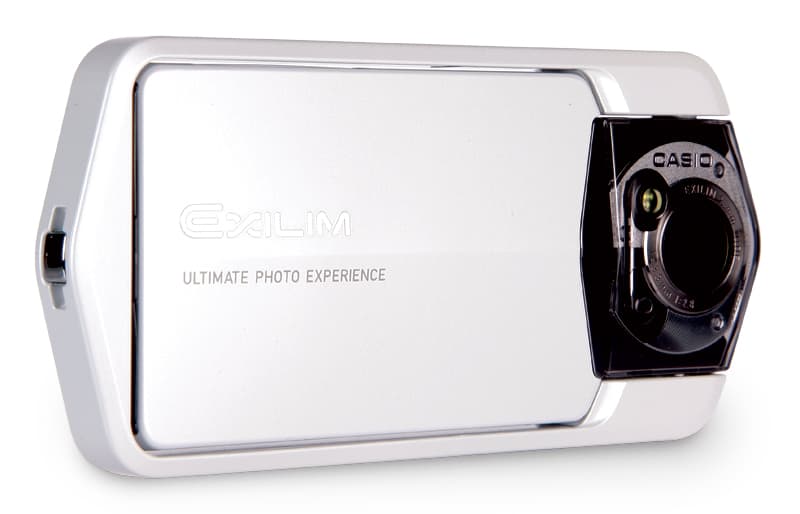While Casio’s Exilim TRYX EX-TR100 looks like a smart phone or a pocket video camera, it is primarily a stills camera. What sets this model apart from the others, though, is the 360° swivel frame and 270° rotatable 3in touchscreen. The design is a bold move and it will be interesting to see whether fortune favours the brave.

Casio TRYX TR100 (in White)
Build and handling
With its stylish design, compact 122.8x59x14.9mm dimensions and 157g weight, it is easy to see why many people mistook the TRYX EX-TR100 for a phone while I was testing it. The frame itself can act as a handle or as a stand, while the screen is easily rotated and great for self-portraits. In landscape format the rotating screen allows viewing from both high and low angles.
In practice, I found the frame useful when resting the camera on a table for self-portraits. However, I often discovered that my natural grip on the frame resulted in my finger obstructing the lens that is flush to the body, so I had to make an effort to keep my hand away from this area of the camera.
The lens is a fixed 21mm (35mm equivalent) f/2.8 Exilim type, which is a good angle of view for street photography. A 4x digital zoom is possible, but image quality deteriorates using this type of zoom mode.
Apart from the on/off button and shutter release, all controls are operated through the 3in touchscreen. I found this to be a little sluggish, and it was all the more frustrating because a lot of time is spent navigating through the menu to switch shooting modes.
Images of up to 12.1 million pixels at an output of 4000×3000 pixels are recorded on a 1/2.3in sensor, which is the same as that found in the Exilim ZR100. As well as JPEG files, the TRYX EX-TR100 records up to 1080p HD videos at 30fps. The similarities with the ZR100 do not end there, because both feature the Exilim Engine High Speed (HS) processor. Most of the shooting modes make use of the HS processor by processing several exposures into one.
There is no manual control over exposure, which puts the TRYX EX-TR100 in the point-and-shoot category, although exposure compensation can be set up to ±2EV. White balance with six presets, auto and custom, and ISO control at 100-3200, are accessed through the main menu.
Performance
For best image quality, the TRYX EX-TR100 should be kept at its fixed 21mm focal setting. Here, image detail in the centre of the frame for objects within 5ft (1.5m) is sharp and crisp. In-camera processing renders a high level of sharpening.
At these settings, the TRYX EX-TR100 reached 22 in our charts at ISO 100 and performed admirably up to ISO 400. From this point on the drop-off in resolution detail is steady and ISO 3200 is soft and patchy with noise. It is a shame, then, that in low-contrast light there is only a low-powered LED light rather than a flash. As expected, the edges show a minor drop-off in sharpness and barrel distortion is present.
Most of the shooting modes, such as HDR, capture a large number of images that are processed into one. There is a lot of information for the processor to deal with, so the processing time is at least 4secs. Slide panorama captures the most during its fixed 360° sweep, with a process time of around 12secs. If speed of use is essential, auto shooting mode is the best option.
I found the fixed-angle panorama much more reliable than other panorama-shooting modes I have used on different models. HDR art is a rather garish filter for extreme HDR effects, although the standard HDR mode in the best shot selector menu is much more subtle and pleasing. Premium auto assesses the scene and selects the appropriate setting.
Video quality is good, and as such this is a good option for high-quality videos from your pocket, although the lack of optical zoom is hindering.

Image: JPEG files boast sharp detail, with the centre ofthe frame particularly crisp. HDR mode brings out the sky here, too
Verdict
Casio has made a bold attempt to produce something a little different with this model, and it is likely to please those photographers who want a camera for casual use.
This is a capable camera, but with limited scope. Those who demand a lot from such a model should look elsewhere.






